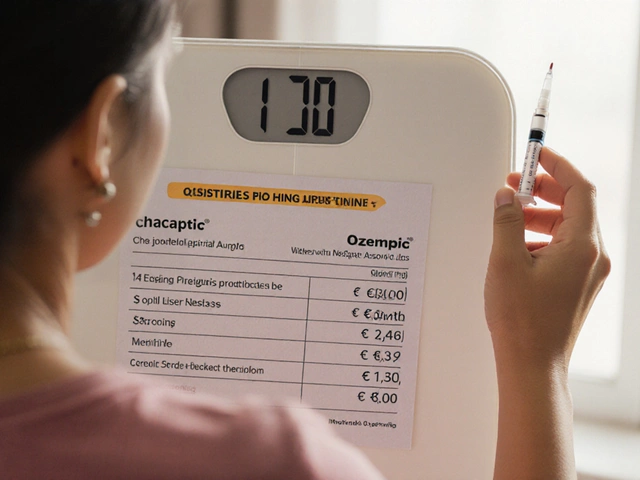Diet Health Score Calculator
Calculate Your Diet Health Score
Based on WHO and Global Burden of Disease data, score your diet using four key metrics.
Key Takeaways
- Diet health is judged by calorie excess, sugar, processed foods, and saturated fat per capita.
- Based on WHO and Global Burden of Disease data, the United States, United Kingdom, Australia, Saudi Arabia, and Mexico top the list of unhealthiest diets in 2025.
- High sugar and processed‑food intake drive obesity, type‑2 diabetes, and heart disease in these nations.
- Policy levers such as soda taxes, front‑of‑pack warnings, and reformulating food products can shift the numbers.
- Individuals can cut down on sugary drinks, choose whole grains over refined carbs, and read nutrition labels to protect their health.
When you hear the phrase unhealthiest diet country, you probably picture people grabbing fast‑food burgers and sugary sodas every day. But the reality is a bit more nuanced. Public‑health researchers combine several metrics-total calories, added‑sugar grams, processed‑food share, and saturated‑fat percentage-to rank nations. By looking at the latest WHO dietary surveys and the Global Burden of Disease (GBD) study for 2025, we can pinpoint exactly which country tops the “unhealthiest diet” list and why.
Unhealthiest diet country is a nation that scores the worst across multiple nutrition‑health indicators, such as high per‑capita calorie intake, excessive added sugar, a large share of ultra‑processed foods, and elevated saturated‑fat consumption. Understanding how these indicators stack up gives a clear picture of where diet‑related disease risk is soaring.
How Experts Measure Diet Health
Health agencies don't rely on a single number. They blend four core metrics:
- Average daily calorie intake - measured in kilocalories (kcal) per person. The WHO recommends 2,500kcal for men and 2,000kcal for women. Anything significantly above signals over‑consumption.
- Added‑sugar consumption - grams per day. The American Heart Association’s cut‑off is 25g for women and 36g for men. Most high‑ranking nations exceed 70g.
- Ultra‑processed food share - the percentage of total calories that come from packaged snacks, ready‑to‑eat meals, and sugary drinks. A share above 50% is a red flag.
- Saturated‑fat intake - grams per day, with the WHO advising less than 10% of total calories from saturated fat.
These numbers are then weighted against health outcomes like obesity prevalence, type‑2 diabetes rates, and cardiovascular‑disease mortality to produce a composite “diet‑health score.”
Ranking Methodology for 2025
Data sources include the WHO Global Health Observatory, the United Nations Food and Agriculture Organization (FAO) food balance sheets, and the Institute for Health Metrics and Evaluation (IHME) GBD study. Each country’s metrics are normalized to a 0‑100 scale (0 = healthiest, 100 = unhealthiest) and then summed. The higher the total, the worse the diet.
For transparency, here’s a quick look at the formula:
Diet‑Health Score = (Calorie Index × 0.30) + (Sugar Index × 0.25) + (Processed‑Food Index × 0.25) + (Saturated‑Fat Index × 0.20)
All indexes are derived by dividing a country’s raw value by the global maximum for that metric, then multiplying by 100.
Top 5 Unhealthiest Diet Countries in 2025
| Rank | Country | Avg Daily Calories (kcal) | Added Sugar (g/day) | Processed‑Food Share (%) | Saturated Fat (g/day) | Composite Score |
|---|---|---|---|---|---|---|
| 1 | United States | 3,650 | 95 | 58 | 34 | 92 |
| 2 | United Kingdom | 3,400 | 88 | 55 | 31 | 88 |
| 3 | Australia | 3,350 | 84 | 53 | 30 | 86 |
| 4 | Saudi Arabia | 3,300 | 80 | 52 | 28 | 84 |
| 5 | Mexico | 3,250 | 78 | 51 | 27 | 82 |
These five nations consistently top the list because they combine high calorie surplus with massive sugar and processed‑food intakes. Notice that the United States leads by a clear margin-its average daily calories exceed the WHO recommendation by nearly 1,200kcal.
Why These Diets Are So Unhealthy
Three big drivers explain the numbers:
- Convenient ultra‑processed foods. In the U.S. and UK, over half of all calories come from packaged snacks, ready‑made meals, and sugary beverages. These items are high in calories but low in fiber, vitamins, and minerals.
- Subsidized commodity crops. Corn, wheat, and soy dominate food production in the U.S., Australia, and Saudi Arabia. Cheap refined carbs turn into soda sweeteners, HFCS, and snack‑food base ingredients, making sugary, salty, and fatty foods cheaper than fresh produce.
- Marketing and cultural norms. Aggressive advertising, especially aimed at children, normalizes daily consumption of fast food and soda. In Mexico, the prevalence of sugary‑drink promotions has historically pushed per‑capita sugar intake above the global average.
These forces create a feedback loop: easy access → higher demand → larger industry → more aggressive promotion.
Health Consequences Tied to the Unhealthiest Diets
Heavy sugar and saturated‑fat consumption directly raise blood glucose and LDL cholesterol. In the top five countries, the data looks grim:
| Country | Obesity Rate (%) | Type‑2 Diabetes Prevalence (%) | Cardiovascular‑Disease Mortality (deaths per 100k) |
|---|---|---|---|
| United States | 36.2 | 11.5 | 210 |
| United Kingdom | 31.5 | 9.8 | 195 |
| Australia | 29.8 | 9.2 | 180 |
| Saudi Arabia | 33.5 | 10.7 | 200 |
| Mexico | 34.9 | 12.0 | 215 |
These figures are well above the global averages (obesity ~13%, diabetes ~6%) and translate into higher health‑care costs, lost productivity, and premature death.

What Governments Are Doing (and What Still Needs Fixing)
Some policies have shown promise:
- Soda taxes. The UK’s Soft Drinks Industry Levy (since 2018) nudged manufacturers to reduce sugar content by an average of 30%.
- Front‑of‑pack warning labels. Mexico introduced mandatory “high‑in” labels in 2020, leading to a 5‑% drop in sugary‑drink purchases within two years.
- Subsidies for fruits and vegetables. Australian state programs provide vouchers for low‑income families, modestly increasing fresh‑produce consumption.
Yet gaps remain: the United States lacks a federal soda tax, and Saudi Arabia’s nutrition education campaigns are still limited in reach. Scaling successful measures-taxes, labeling, and subsidies-can shift the diet‑health score downward.
Practical Tips for Individuals
Even if you live in a country with a poor national diet, you can make choices that protect your health:
- Swap sugary drinks for water or unsweetened tea. Cutting just one soda a day saves roughly 150kcal and 40g of added sugar.
- Read nutrition labels. Aim for products with less than 5g of added sugar per serving and under 10% of calories from saturated fat.
- Prioritize whole foods-fresh fruits, vegetables, legumes, nuts, and whole grains. These foods are naturally low in added sugars and high in fiber.
- Cook more at home. Home‑prepared meals let you control oil, salt, and sugar quantities.
- Use portion‑size guides. A typical fast‑food meal can contain 1,200kcal-roughly half of an average day’s total intake.
Small, consistent changes add up to big health benefits over time.
Frequently Asked Questions
Which metric matters most for diet health?
Added sugar is often the biggest driver of metabolic disease because it spikes blood glucose and contributes extra calories without satiety. However, a holistic view-considering calories, processed‑food share, and saturated fat-provides the most accurate picture.
Why does the United States rank highest?
The U.S. combines the world’s highest per‑capita calorie surplus with massive sugar consumption (≈95g/day) and a 58% processed‑food share. Subsidies make cheap, calorie‑dense foods widely available, and a lack of federal soda tax discourages reduction.
Can a single policy change a country’s diet score?
Yes. The UK’s sugar‑sweetened beverage levy led manufacturers to cut average sugar content by about 30% within two years, improving the nation’s sugar‑intake metric and nudging the overall score downward.
How reliable are the data sources?
We rely on WHO’s Global Health Observatory, FAO food balance sheets, and the IHME GBD study-all regarded as gold‑standard public‑health databases. They undergo peer review and are updated annually.
What can developing countries learn from this ranking?
Even nations with lower incomes can avoid the worst outcomes by limiting ultra‑processed imports, promoting local agriculture, and enforcing front‑of‑pack labeling early on. Prevention is far cheaper than treating diet‑related disease later.










